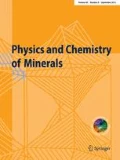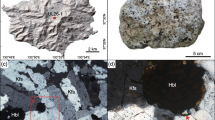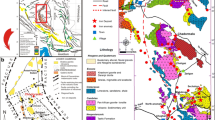Abstract
The pseudomorphic transformation of magnetite into hematite (martitization) is widespread in geological environments, but the process and mechanism of this transformation is still not fully understood. Micro- and nano-scale techniques—scanning electron microscopy, focused ion bean transmission electron microscopy, and Raman spectroscopy—were used in combination with X-ray diffraction, Curie balance and magnetic hysteresis analyses, as well as Mössbauer spectroscopy on martite samples from a banded iron formation (2.9 Ga, Dharwar Craton, India), and from lateritic soils, which have developed on siliciclastic and volcanic rocks previously affected by metamorphic fluids (Minas Gerais, Brazil). Octahedral crystals from both samples are composed of hematite with minor patches of magnetite, but show different structures. The Indian crystals show trellis of subhedral magnetite hosting maghemite in sharp contact with interstitial hematite crystals, which suggests exsolution along parting planes. Grain boundary migrations within the hematite point to dynamic crystallization during deformation. Dislocations and fluid inclusions in hematite reflect its precipitation related to a hydrothermal event. In the Brazilian martite, dislocations are observed and maghemite occurs as Insel structures and nano-twin sets. The latter, typical for the hematite, are a transformation product from maghemite into hematite. For both samples, a deformation-induced hydrothermally driven transformation from magnetite via maghemite to hematite is proposed. The transformation from magnetite into maghemite comprises intermediate non-stoichiometric magnetite steps related to a redox process. This study shows that martite found in supergene environment may result from earlier hypogene processes.












Similar content being viewed by others

References
Alva-Valdivia LM, Urrutia-Fucugauchi J (1998) Rock magnetic properties and ore microscopy of the iron ore deposit of Las Truchas, Michoacan, Mexico. J Appl Geophys 38:277–299
Angerer T, Hagemann SG, Danyushevsky V (2012) Geochemical evolution of the Banded iron formation-hosted high-grade iron ore system in the Koolyanobbing Greenstone Belt, Western Australia. Econ Geol 107:599–644
Bachmann HG (1954) Uber Martiterze von Talberg (Viirmland) Schweden. Neues Jahrb Mineral 6:131–136
Banerji PK (1984) On some geochemical features of the vanadiferous magnetite deposits of Kumhardubi and Betjharan, Mayurbhanj district, Orissa, India. Chem Geol 43:257–269
Barbosa PF, Lagoeiro L (2010) Crystallographic texture of the magnetite-hematite transformation: evidence for topotactic relationships in natural samples from Quadrilátero Ferrífero, Brazil. Am Mineral 95:118–125
Beukes NJ, Mukhopadhyay J, Gutzmer J (2008) Genesis of high-grade iron ores of the Archean iron ore group around Noamundi, India. Econ Geol 103:365–386
Brown DA, Sherrif B, Sawick JA (1997) Microbial transformation of magnetite to hematite. Geochim Cosmochim Acta 61:3341–3348
Cabral AR, Lehman B, Tupinamba M, Wiedenbeck M, Brauns M (2011) Geology, mineral chemistry and tourmaline B isotopes of the Córrego Bom Sucesso area, southern. Serra do Espinhaço, Minas Gerais, Brazil: implications for Au–Pd–Pt exploration in quartzitic terrain. J Geochem Explor 110:260–277
Cabral AR, Wiedenbeck M, Koglin N, Lehmann B, de Abreu FR (2012) Boron-isotopic constraints on the petrogenesis of hematitic phyllite in the southern Serra do Espinhaço, Minas Gerais, Brazil. Lithos 140–141:224–233
Colombo U, Cazzarini F, Lanzavecchia G, Sironi E (1965) Magnetite oxidation: a proposed mechanism. Science 147:1033
Davis BL, Rapp G, Walawender MJ (1968) Fabric and structural characteristics of the martitisation process. Am J Sci 266:482–496
Day R, Fuller MD, Schmidt VA (1977) Magnetic hysteresis properties of synthetic titanomagnetites. Phys Earth Planet Inter 13:260–266
De Boer CB, Dekkers MJ (2001) Unusual thermomagnetic behaviour of haematites: neoformation of a highly magnetic spinel phase on heating in air. Geophys J Int 144:481–494
de Faria DLA, Venancio-Silva S, de Oliveira MT (1997) Raman microspectroscopy of some iron oxides and oxyhydroxides. J Raman Spectrosc 28:873–878
El Mendili Y, Bardeau JF, Randrianantoandro N, Gourbil A, Greneche JM, Mercier AM, Grasset F (2010) New evidence of in situ laser irradiation effects on γ-Fe2O3 nanoparticles: a Raman spectroscopic study. J Raman Spectrosc 42:239–242
Gehring AU, Fischer H, Louvel M, Kunze K, Weidler PG (2009) High temperature stability of natural maghemite: a magnetite and spectroscopic study. Geophys J Int 179:1361–1371
Gruner JW (1922) Organic matter and the origin of the Biwabik iron-bearing formation of the Mesabi range. Econ Geol 17:407–460
Gruner JW (1926) Magnetite–martite–hematite. Econ Geol 21:375–393
Gruner JW (1929) Structural reasons for oriented intergrowths in some minerals. J Mineral Soc Am 14:227–231
Hanesh M (2009) Raman spectroscopy of iron oxides and (oxy) hydroxides at low laser power and possible implications in environmental magnetic studies. Geophys J Int 177:941–948
Jayananda M, Chardon D, Peucat J-J, Capdevila R (2006) 2.61 Ga potassic granites and crustal reworking in the western Dharwar craton, Southern India: tectonic, geochronological and geochemical constraints. Precambrian Res 150:1–26
Joint Committee on Powder Diffraction Standard (1974) Selected powder diffraction data for minerals. Joint Committee on Powder Diffraction Standards, Pennsylvania
Kolb JH, Rogers A, Sinderen S, Vennemann T, Böttcher ME, Meyer FM (2004) The role of a transcrustal shear zone in orogenic gold mineralization at the Ajjanahalli mine, Dharwar craton, South India. Econ Geol 99:743–759
Kullerud G, Donnay G, Donnay JDH (1969) Omission solid solution in magnetite: kenotetrahedral magnetite. Z Kristallogr Bd 128:l–17
Kumar B, Das Sharma S (1998) Carbon isotope systematics of graphites from Dharwar craton, Southern India: implications to their source and post-depositional alterations. Curr Sci 75:396–397
Lagoeiro LE (1998) Transformation of magnetite to hematite and its influence on the dissolution of iron-oxide minerals. J Metamorph Geol 16:415–423
Lepp H (1957) Stages in the oxidation of magnetite. Am Mineral 42:679–681
Lindsley DH (1976) Experimental studies of oxide minerals. In: Rumble D III (ed) Reviews of mineralogy, oxide minerals, vol 32, 2nd edn. BookCrafters, Chelsea, pp L61–L88
Morris RC (1980) A textural and mineralogical study of the relationship of iron ore to banded iron ore formation in the Hamersley iron province of Western Australia. Econ Geol 75:184–209
Morris RC (1985) Genesis of iron ore in banded iron formation by supergene and supergene-metamorphic processes—a conceptual model. In: Wolf KH (ed) Handbook of strata-bound and stratiform ore deposits, vol 13. Elsevier, Amsterdam, pp 73–235
Mücke A, Cabral AR (2005) Redox and non-redox reactions of magnetite and hematite. Chem Erde 65:271–278
Ohmoto H (2003) Non-redox transformations of magnetite–hematite in hydrothermal systems. Econ Geol 98:157–161
Orberger B, Wagner C, Wirth R, Quirico E, Gallien JP, Derré C, Montagnac G, Noret A, Jayananda M, Massault M, Rouchon V (2012) Origin of iron-oxide spherules in the banded iron formation of the Bababudan Group, Dharwar Craton, Southern India. J Asian Earth Sci 52:31–42
Otake T, Wesolowski DJ, Anovtz LM, Allard LF, Ohmoto H (2007) Experimental evidence for non-redox transformations between magnetite and hematite under H2-rich hydrothermal conditions. Earth Planet Sci Lett 257:60–70
Roberts AP, Cui Y, Verosub KL (1995) Wasp-waisted hysteresis loops: mineral magnetic characteristics and discrimination of components in mixed magnetic systems. J Geophys Res 100(B9):17909–17924
Sarma SD, Fletcher IR, Rasmussen B, McNaughton NJ, Mohan MR, Groves DI (2011) Archean gold mineralization synchronous with late cratonization of the Western Dharwar Craton, India: 2.52 Ga U–Pb ages of hydrothermal monazite and xenotime in gold deposits. Miner Depos 46:273–288
Shebanova ON, Lazor P (2003a) Raman study of magnetite (Fe3O4): laser-induced thermal effects and oxidation. J Raman Spectrosc 34:845–852
Shebanova ON, Lazor P (2003b) Raman spectroscopic study of magnetite (FeFe2O4): a new assignment for vibrational spectrum. J Solid State Chem 174:424–430
Srinivasan R, Ojakangas RW (1986) Sedimentology of quartz-pebble conglomerates and quartzites of the Archaean Bababudan Group, Dharwar Craton, South India: evidence for early crustal stability. J Geol Soc India 94:199–214
Swanson-Hysell NL, Feinberg JM, Berquô TS, Maloof AC (2011) Self-reversed magnetization held by martite in basalt flows from the 1.1 billion-year-old Keweenawan-rift, Canada. Earth Planet Sci Lett 325:171–184
Tarling DH (1983) Paleomagnetism, principles and applications in geology, geophysics and archaeology. Chapman and Hall, New York
Tauxe L, Mullender TAT, Pick T (1996) Potbellies, wasp-waisted, and superparamagnetism in magnetic hysteresis. J Geophys Res 101(B1):571–583
Taylor PN, Chadwick B, Moorbath S, Ramakrishanan M, Viswanatha MN (1984) Petrography, chemistry and isotopic ages of peninsular gneisses, Dharwar, acid volcanics and Chitradurga granite with special reference to Archaean evolution of Karnataka craton, Southern India. Precambrian Res 23(3–4):349–375
Thompson R, Oldfield M (1986) Environmental magnetism. Allen and Unvin, London
Tuček J, Zboril R (2005) Zero-field and in-field Mössbauer spectroscopy as a tool for structural and magnetic characterization of maghemite (γ-Fe2O3) nanoparticles. Czechoslov J Phys 55:893–911
Wasilewski P (1973) Magnetic hysteresis in natural materials. Earth Planet Sci Lett 20:67–72
Weber H-P, Hafner SS (1971) Vacancy distribution in nonstoichiometric magnetites. Z Kristallogr New Cryst Struct 133:327–340
Wirth R (2004) Focused Ion Beam (FIB): a novel technology for advanced application of micro-and nanoanalysis in geosciences and applied mineralogy. Eur J Mineral 16:863–876
Wirth R (2009) Focused ion beam (FIB) combined with SEM and TEM: advanced analytical tools for studies of chemical composition, microstructure and crystal structure in geomaterials on a nanometer scale. Chem Geol 261:217–229
Acknowledgments
This project was funded by the national PNP Planétologie, PRES UNIVERSUD Planétologie and the UMR IDES 8148 (CNRS-UPS) and COFECUB-CAPES (UPS, Orsay France-UFMG, Belo Horizonte, Brazil). It was part of the ESF project “Early Habitats of Early life”. The authors thank Rémy Pichon, Luce Delabesse, Valérie Godard and Olivier Dufour (UMR IDES), Gilles Montagnac (ENS-Lyon, Lyon) and Anja Schreiber (GFZ-Potsdam) for technical help. The authors thank M. Rieder for handling the manuscript, A. Cabral, H. Siemes and T. Angerer for comments and suggestions to fundamentally improve the manuscript.
Author information
Authors and Affiliations
Corresponding author
Appendix
Appendix
Raman spectra of goethite in the Indian sample. The spectra were acquired under the conditions reported in the text and at the same spot every 40 s. Red lines correspond to the position of active modes for goethite (de Faria et al. 1997; Hanesh 2009). A band at ~418 cm−1 (dashed red line) on the wing of the largest peak at 385 cm−1 has also been reported by Hanesh (2009). According to these authors, the broad bands above 1,000 cm−1 are not “diagnostic” for goethite and may record some contaminant species. Apart from a decrease in the background fluorescence between 1,000 and 1,400 cm−1 with increasing laser exposition time, there is no significant variation in the observed spectral modes, either in position or in intensity, for a total time of irradiation up to 8 min. Moreover, there is no appearance of new bands, which would indicate a possible transformation of goethite under the laser beam (in maghemite or hematite; Hanesh 2009).

Rights and permissions
About this article
Cite this article
Orberger, B., Wagner, C., Tudryn, A. et al. Micro- to nano-scale characterization of martite from a banded iron formation in India and a lateritic soil in Brazil. Phys Chem Minerals 41, 651–667 (2014). https://doi.org/10.1007/s00269-014-0679-8
Received:
Accepted:
Published:
Issue Date:
DOI: https://doi.org/10.1007/s00269-014-0679-8



